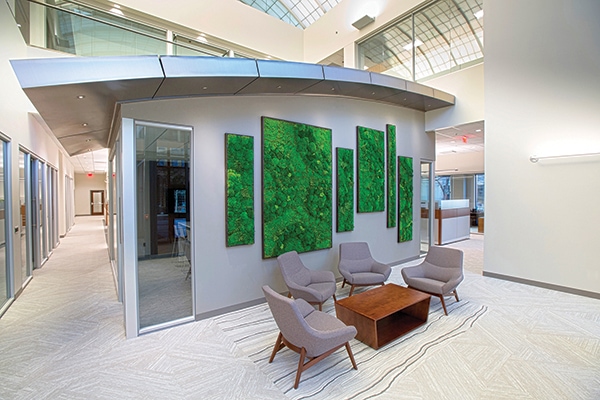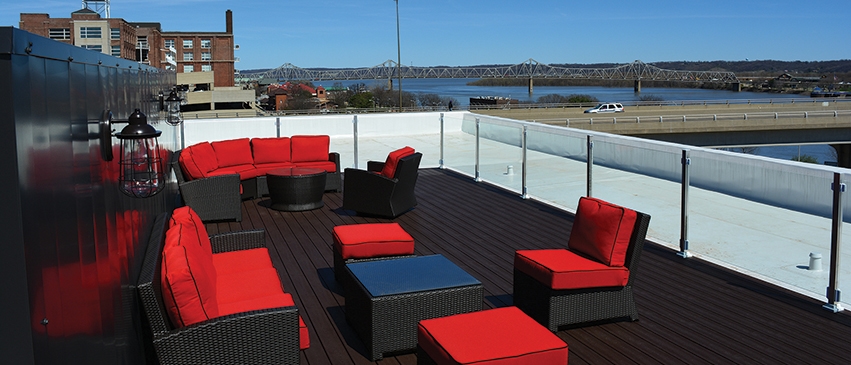Way before COVID-19—like way, way before—the earliest offices in history were open-air. Their boardrooms were open fields and their break rooms were caves. Historically, humans have spent most of their time outdoors, rather than sealed inside buildings.
Whether we know it or not, we are intrinsically drawn to nature. Over the decades, we have developed technologies to harness our environment and bring it indoors. By developing artificial lighting, heating and cooling, we can now use the built environment to live and work anywhere, in relative comfort. We spend more than 90 percent of our lives in the built environment, and as adults we spend nearly half our day inside a building. While other factors like diet and exercise affect our health, we cannot ignore the places in which we choose to spend so much of our lives—and the impact these environments have on who we are.
A Holistic Approach
There is no one answer to creating healthier buildings and no single design strategy that will cure everything. Rather, our path to wellness is a holistic approach that is both additive in nature and human-centric, incorporating elements that enhance people’s daily lives.

People are the most valuable assets in any company. For a company to be truly successful, their employees must be happy, healthy and productive. Certainly stress plays a major role in these factors, and stress at work is inevitable. But, well-designed spatial environments can help to combat some everyday sources of stress.
Fashioning healthier office environments starts with designing well-lit active spaces that create a sense of place and nurture a connection to both nature and our co-workers. Integrating natural daylight and access to views of the outside has proven to positively impact an employee’s productivity, satisfaction and happiness. When it is not possible to bring daylight into a space, textures, colors, plants and artwork can be used to enrich secluded environments—creating an atmosphere of discovery and excitement where it might otherwise feel barren and unwelcoming.
By embracing these natural elements in the built environment, we can develop unique spaces and help to facilitate a connection to the outdoors. This in turn can improve productivity and employee well-being by reducing stress and decreasing the average amount of sick time we need to take.
Active and Private Spaces
Active spaces promote physical, mental and social wellness. For example, it may be more time-efficient to have a printer at everyone’s desk, but there are also physical, emotional, social and financial benefits to having a centralized printer. Getting up and moving throughout the day can have a tremendous positive impact on physical wellness and overall happiness. Random interactions help spark ideas, fostering a culture of innovation and creativity. All too often, the best ideas and conversations happen spontaneously while standing in line for lunch or bumping into a coworker at the coffee maker, rather than in the conference room.
As active spaces become increasingly more open, it is important to be intentional about designing private spaces, too. These can be as simple as a small phone booth or huddle room, or an intimate outdoor patio space that could be used for a private conversation, some much-needed focus time, or simply a quick moment to one’s self. Allowing employees the ability to balance how and where they work with the tasks they need to complete—and even with their mood and energy levels—has been shown to have a positive impact on employee engagement, satisfaction and wellbeing in a world in which employers are constantly competing to retain the very best.
Fostering Connection
You, too, can make your office environment happier and healthier. All of us have varying abilities to control the environment around us. Look for little ways every day to create active spaces that connect to nature. It may be as simple as adjusting the angle of your chair to look out the window, walking across the office to a different printer, or adding a plant and some color to enhance your space. The most successful built environments are ones that foster a sense of discovery and connection. The places where we spend so much of our time can and should enhance our daily lives. PM
Jeremy Collins, AIA, LEED AP BD+C, is a project architect with Farnsworth Group, Inc.




